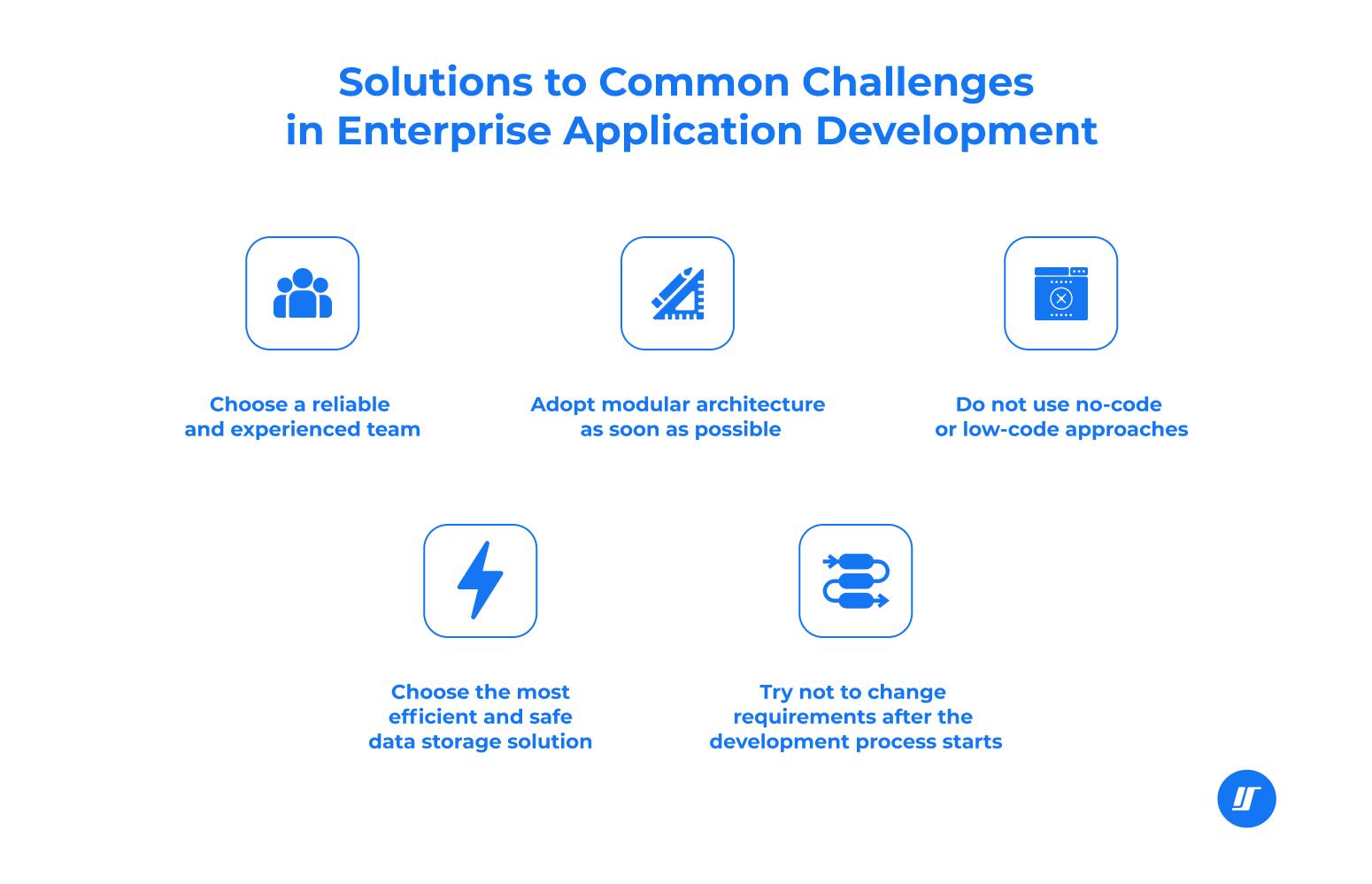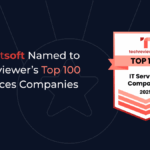Updated: October 15, 2024
Enterprise-level companies face very different challenges from startups and small businesses. This includes enterprise app development. While startups commonly struggle with challenges like market research and analysis, larger companies face difficulties with fast and smooth legacy software upgrades, integrations, enhanced data security, etc.
Enterprise software development is more complex than creating an eCommerce app because you cannot just look at similar products your competitors have made for their internal use. In this article, we’ll cover the most crucial challenges of creating enterprise software, strategies to overcome them, and, of course, solutions.
What is Enterprise Application Development?
Enterprise application development is the process of designing, building, and deploying software applications tailored to meet the specific needs of an organization. Unlike generic software solutions, enterprise applications are customized to integrate seamlessly with existing systems, databases, and third-party applications. This integration is crucial for supporting business operations, improving efficiency, and enhancing decision-making processes. By addressing unique business requirements, enterprise application development ensures that the software aligns with the company’s goals and workflows, ultimately driving business growth and operational excellence.
Challenges of Enterprise Application Development
The main challenge of developing enterprise applications is finding the optimal ways to ensure the following features.
Software Flexibility and Scalability
Even though an enterprise is a big company with a well-tailored business strategy and processes, the pandemic showed that owners should be equally ready for both growing and downsizing. For this reason, your enterprise software must be ready for the upgrade when new features or functions that optimize certain processes for your employees are painlessly added to the app. At the same time, your enterprise software should allow turning off or removing modules and features that are no longer required without impairing the performance of other remaining parts of the software. Business apps play a crucial role in enhancing operational efficiency and employee engagement within large organizations.
Making an enterprise app properly scalable requires extra knowledge and attention to its complex structure, technologies, and other resources.
Changing Business Requirements
This one is probably the most challenging for your development team. It is crucial for the development process to define what problems your enterprise software should solve in the present and in the future. Constantly changing requirements will very likely affect:
- deadlines;
- budget;
- motivation of team members to continue working on your project;
- overall efficiency.
You may think that you’re suggesting a minor change. However, when a complex enterprise application is half or almost finished, even a minor change in requirement leads to significant changes in code and additional testing.
Enhanced Security
Enterprise software often handles highly sensitive information, including customer and company data, that is extremely valuable and must be protected by advanced technical means. Usually, there are specific regulations and standards that govern the implementation of security measures in enterprise software.
A vulnerability in one application may compromise the security of the whole corporate network. That’s why ensuring the highest security standards is the top priority and one of the biggest enterprise application development challenges.
Data Storage and Processing in Enterprise Resource Planning
Proper data storage and analysis of core business processes remain among the common challenges of business software development, including such businesses as enterprises. This is a challenge because enterprise software generates, processes, and stores massive amounts of data. In addition to high-volume and secure data storage capabilities, this software must retrieve necessary data from the storage fast.
This one is especially challenging when all or the majority of this data is unstructured. So, without a carefully elaborated application architecture and infrastructure, your enterprise software won’t be as efficient and fast-working as it should be.
Integrations with Third-Party APIs, Systems, or Other Software
Many enterprises use legacy systems with monolithic architecture that was made years or even decades ago. Monolithic legacy systems are very challenging to enhance with complex integrations with third-party software products or application programming interfaces (APIs). Enterprise resource planning (ERP) systems play a crucial role in managing and integrating these core business processes in real-time.
In case your enterprise business goals and needs cannot be fulfilled without integrating data processing, AI-enhanced, or other systems in your legacy, you need to consult with a reliable CTO (Chief Technical Officer) first to come up with the most effective enterprise app upgrade or development strategy. When it comes to outdated legacy systems and integrations with modern APIs, very likely you will have to start with legacy upgrading and transforming its architecture to microservice-based.
Finding Experienced and Reliable Technical Specialists
Even though the number of software development specialists around the world continues to grow each year and is reaching 28 million, it is still challenging to find tech experts fast for your project, especially when you want to hire specialists for your in-house team.


Not all tech specialists on the market are experienced in enterprise development and your industry. So, finding the ones who fit your project perfectly may take weeks or even months for your recruitment department. Human resource management applications can streamline this process by automating HR tasks, enhancing employee engagement, and ensuring compliance with labor laws.
Legacy Systems and Integration
Legacy systems are outdated software applications that have been in use for a long time, often forming the backbone of an organization’s IT infrastructure. However, these systems can become a bottleneck when it comes to modernizing and streamlining business processes. Integrating legacy systems with new enterprise applications is a complex but essential task. Enterprise application development involves incorporating modern technologies such as cloud computing, artificial intelligence, and the Internet of Things (IoT) into these legacy systems. This integration enhances performance, scalability, and security, allowing businesses to leverage their existing investments while adopting new capabilities to stay competitive.
Business-IT Communication Gaps
Effective communication between business and IT teams is crucial for the success of enterprise application development. However, communication gaps can lead to delays, rework, and inefficient use of resources. These gaps often arise from differences in language, priorities, and understanding of business requirements. To bridge this divide, organizations should adopt agile development methodologies like Scrum or Kanban. These methodologies promote collaboration, transparency, and continuous improvement, ensuring that both business and IT teams are aligned and working towards common goals. By fostering a culture of open communication and iterative feedback, businesses can mitigate risks and enhance the efficiency of their development process.
Adapting to Agile Development
Agile development is an iterative and incremental approach to software development that emphasizes flexibility, collaboration, and rapid delivery. Adapting to agile development requires a significant cultural shift within an organization. It involves breaking down silos, empowering teams, and embracing change. For enterprise application development teams, adopting agile methodologies means being able to respond quickly to changing business requirements, improve software quality, and reduce time-to-market. Agile practices such as regular stand-ups, sprint planning, and retrospectives help teams stay focused and continuously improve their processes. By embracing agile development, organizations can ensure that their enterprise applications remain relevant and effective in a dynamic business environment.
Strategies for Overcoming Enterprise Challenges
There are hardly any specific strategies that fit exclusively for enterprise application development. Instead, there are some commonly accepted universal approaches that have proven their effectiveness in software development regardless of its type. Here are several strategic steps that can help in dealing with challenges in a fast and cost-effective manner.
- Define the technical and business requirements for your enterprise software.
- Consult with professional and reliable software development experts on software infrastructure, technologies, databases, team composition, and many other crucial factors before initiating the development process.
- Research and analyze the software products created or used by other enterprises, especially in your industry. Yes, it may be difficult because such software is mostly for the company’s internal use. However, if you cannot accomplish difficult tasks, you wouldn’t be fulfilling your current position in the enterprise company.
- Make sure your enterprise app is user-friendly for employees or its target audience. User experience and user interface are equally important, and make sure an app is intuitive and easy to use. In case the enterprise app’s interface needs to be complex, someone from the development team will have to create a user guide or teach staff how to use this software.
- Select the optimal tech stack depending on the platform.
- Log the development process and prepare exhaustive documentation. You will 100% need it in the future for upgrading your software or detecting weak spots or flaws.
- Perform extensive testing and collect feedback from your enterprise application users.
Executing these steps carefully and consecutively will drastically decrease the number of potential obstacles during the development process.
Solutions to Common Challenges in Enterprise Application Development
Choose a Reliable and Experienced Team
This is the core solution to most challenges. While finding skilled tech specialists for your in-house team may be challenging, you have an even better option to hire a dedicated team or staff augmentation specialists from a software development company. This alternative offers multiple benefits for businesses of all sizes, including enterprises.
Adopt Modular Architecture as Soon as Possible
Enterprise apps will help to achieve advanced scalability and facilitate the integration of modules and systems into the application. Always ensure that the security measures of your application override the corresponding measures in integrated parts. This way, the vulnerabilities in third-party solutions will less likely compromise your software.
Do Not Use No-Code or Low-Code Approaches
They save time and money at the cost of security. These approaches may be trendy and have undeniable benefits. However, even if your project budget is low, these software development approaches will bring you a fair share of drawbacks in software cybersecurity, scalability, and overall performance.
Choose the Most Efficient and Safe Data Storage Solution
Companies can choose between storing data locally or in clouds. Local data storage is more secure and self-sufficient. Cloud storage is generally cheaper and more convenient but is also more vulnerable to data breaches. Besides, it makes your enterprise too dependent on third parties, such as Internet providers and cloud service providers. A good solution would be using both cloud and local storage options by dividing the data according to its importance. This way, you can store the most confidential information and vital backups locally while sending low-priority and harmless data to cloud storage. Effective data management is crucial for supply chain management, as it enhances operational efficiency and visibility across the supply chain.
Try Not to Change Requirements After the Development Process Starts
You are the boss of the project, so you can request changes at every stage of the product development process. However, you should do your very best to define what exactly you want from your new enterprise app and what functionality it should have. Otherwise, every change will result in project deadline prolongation and budget increase. In case you don’t want or cannot provide a final set of requirements at the initial stage, you may consider starting with building an MVP version.
Even the biggest challenge has at least one solution when you consult and work with professionals.
Final Words
All the enterprise application development challenges listed in this article may seem difficult to overcome. However, if you know what exactly you want as the ultimate result, have at least a basic understanding of app development and software development processes, have a trusted tech expert to consult, and can gather a top-quality team, building an application for your enterprise will go smoothly.
As a company that has been providing software development solutions for businesses from startups to enterprises since 2007, Intellectsoft offers high-quality enterprise software development services for various industries. Even though our domain focus lies in fintech, insurance, healthcare, and construction, we have successfully provided and continue to provide web and mobile solutions to many other industries as well.
If you’re looking for a reliable and professional enterprise application development partner, we look forward to receiving your requirements. Just contact us via the registration form and tell us what your business needs to grow stronger, and get a bespoke and efficient solution from our team.
Subscribe to updates
Source link












